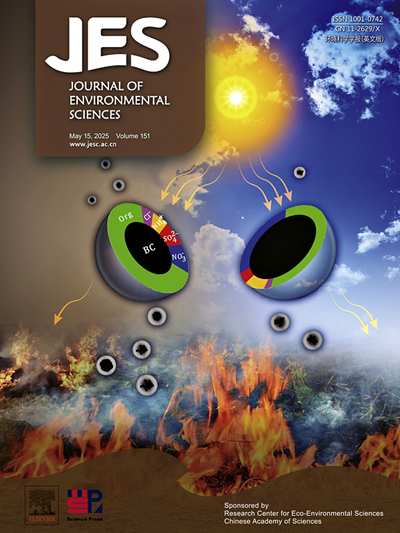生物炭中多环芳烃的去除机理及其对植物生长的影响
IF 5.9
2区 环境科学与生态学
Q1 ENVIRONMENTAL SCIENCES
引用次数: 0
摘要
生物炭在制备过程中会产生多环芳烃(PAHs),对环境和人体健康有潜在的危害。现有的研究主要集中在不同方法对生物炭中多环芳烃的去除效果上。然而,关于多环芳烃的去除机制和处理后的生物炭对植物生长的影响的报道很少。本研究将污水污泥、猪粪和酒糟分别在300℃、500℃和600℃热解制备生物炭。对制备的生物炭进行热处理、水洗和水热处理,探讨生物炭中多环芳烃的去除机理,并评价其对植物生长的影响。结果表明,水热法、热处理法和水洗法对生物炭中多环芳烃的去除率分别为36.79% ~ 86.09%、80.00 % ~ 89.90%和19.15% ~ 72.40%。与热处理和水洗处理相比,水热处理的效果更好。在热解温度为300℃的污泥生物炭中,水热法对PAHs的去除率达到86.09%,热解温度为80℃,热解时间为2 h, PAHs的去除机制主要包括疏水相互作用减弱和热脱附。发芽结果表明,处理过的生物炭降低了绿豆幼苗丙二醛含量,提高了超氧化物歧化酶、过氧化物酶和过氧化氢酶活性。水热处理后的污泥生物炭比原始生物炭更有利于绿豆的生长。本研究为生物炭的安全利用提供了一条有效途径。本文章由计算机程序翻译,如有差异,请以英文原文为准。

Removal mechanisms of polycyclic aromatic hydrocarbons in biochar and its effects on plant growth
Polycyclic aromatic hydrocarbons (PAHs) could be produced during the preparation of biochar, which may pose potential risks to the environment and human health. Existing research mainly focuses on the removal efficiency of PAHs in biochar using different methods. Still, there are few reports on the removal mechanism of PAHs and the impact of treated biochar on plant growth. This study prepared biochar by pyrolysis of sewage sludge, pig manure, and distillers grains at 300, 500, and 600 °C, respectively. The prepared biochar was subjected to thermal treatment, water washing treatment, and hydrothermal treatment to investigate the removal mechanism of PAHs in biochar and evaluate its effect on plant growth. The results showed that the removal rates of PAHs in biochar by hydrothermal treatment, thermal treatment, and water washing were 36.79 %-86.09 %, 80.00 %-89.90 %, and 19.15 %-72.40 %, respectively. Compared with thermal treatment and water washing treatments, the hydrothermal treatment is more effective. The removal rate of PAHs in sludge biochar with a pyrolysis temperature of 300 °C by hydrothermal treatment reached 86.09 % under 80 °C for 2 h. The removal mechanisms of PAHs include weakening hydrophobic interaction and thermal desorption. The germination results indicate that treated biochar reduces malondialdehyde content in mung bean seedlings and increases superoxide dismutase, peroxidase, and catalase activities. Sludge biochar after hydrothermal treatment is more conducive to the growth of mung beans than pristine biochar. This study provides an effective pathway for the safe utilization of biochar.
求助全文
通过发布文献求助,成功后即可免费获取论文全文。
去求助
来源期刊

Journal of Environmental Sciences-china
环境科学-环境科学
CiteScore
13.70
自引率
0.00%
发文量
6354
审稿时长
2.6 months
期刊介绍:
The Journal of Environmental Sciences is an international journal started in 1989. The journal is devoted to publish original, peer-reviewed research papers on main aspects of environmental sciences, such as environmental chemistry, environmental biology, ecology, geosciences and environmental physics. Appropriate subjects include basic and applied research on atmospheric, terrestrial and aquatic environments, pollution control and abatement technology, conservation of natural resources, environmental health and toxicology. Announcements of international environmental science meetings and other recent information are also included.
 求助内容:
求助内容: 应助结果提醒方式:
应助结果提醒方式:


